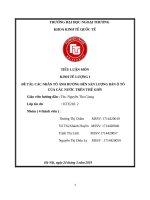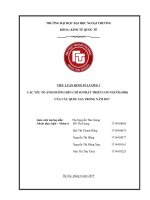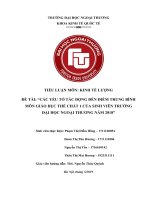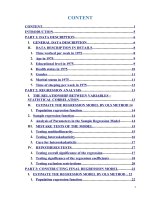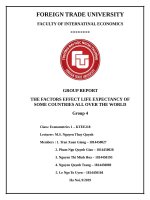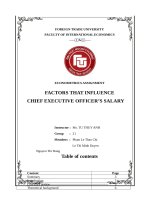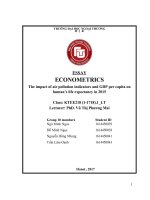tiểu luận kinh tế lượng THE INFLUENCE OF FACTORS ON UNITED KINGDOMS GDP FROM 1965 TO 2010
Bạn đang xem bản rút gọn của tài liệu. Xem và tải ngay bản đầy đủ của tài liệu tại đây (278.85 KB, 26 trang )
FOREIGN TRADE UNIVERSITY
FACULTY OF INTERNATIONAL ECONOMY
REPORT ECONOMETRICS
THE INFLUENCE OF FACTORS
ON UNITED KINGDOM'S GDP FROM 1965 TO 2010
Instructor: Dr. Chu Thi Mai Phuong
Class: Anh 7 - KDQT – K57
1. Đỗ Thu Trang
2. Nguyễn Thị Thúy Quỳnh
1815520229
1815520217
3. Lê Thị Thu Hà
1815520163
Hanoi, October 2019
1
TABLE OF CONTENTS
I. INTRODUCTION ..................................................................................................... 3
II. LECTURE REVIEW ................................................. Error! Bookmark not defined.
III. METHODOLOGY ................................................................................................. 7
1. Our model .......................................................................................................... 7
2. Data ...................................................................... Error! Bookmark not defined.
3. Describe Variables ............................................................................................. 9
3.1. Summary Statistic ..................................................................................... 9
3.2.
Correlation matrix .................................................................................. 10
3.2.1. Correlation between independent variables and dependent variable 10
3.2.2. Correlation between independent variables ........................................ 10
4. Regression run ................................................................................................. 11
IV.TESTING ................................................................................................................ 12
1. Testing hypothesis: .......................................................................................... 12
1.1. Testing an individual regression coefficient ......................................... 12
1.2.
Testing the overall significance .............................................................. 13
2. Testing the model’s problems: ....................................................................... 13
2.1.
Multicollinearity...................................................................................... 13
2.2. Heteroskedasticity ...................................................................................16
2.3. Autocorrelation ....................................................................................... 18
2.4.
Normality of residual Test ..................................................................... 19
3. Summary table: ............................................................................................... 23
V. CONCLUSION ....................................................................................................... 24
VI. REFERENCES ....................................................... Error! Bookmark not defined.5
2
I. INTRODUCTION:
One of the basic indicators reflecting economic growth in economic scale, level of
economic development per capita, economic structure and changes in price level of a
country is GDP. Gross Domestic Product (GDP) is one of the determinants of country’s
economic growth. It represents the economic health of a country, presents a sum of a
country's production which consists of all purchases of goods and services produced by a
country and services used by individuals, firms, foreigners and the governing bodies.
GDP is used as an indicator for most governments and economic decisionmakers for planning and policy formulation. GDP helps the investors to manage
their portfolios by providing them with guidance about the state of the economy.
Calculation of GDP provides with the general health of the economy.
With all its importance to economic growth, studying on GDP is vital for all nations.
Any nation wants to maintain a growing economy along with monetary stability
and jobs for the population; GDP is one of the concrete signals for government
efforts. Therefore, studying the relationship between GDP and the important
factors that affect GDP such as Family Expenditure, Exports, and Government
Debt will help government look for trends in GDP growth and enable to change
its policies to achieve set goals to promote economic growth.
United Kingdom has the fifth largest economy in the world at the exchange rate on
the market and the 6th in the world by purchasing power parity. We can see the
positive results today, the way each household's spending and export of the
country plays a very important role for the economy of this union. Besides the
impact of the spending from households and exports of goods on the increase, the
government debt is also a critical factor impacting GDP of the United Kingdom.
Studying the theories and indicators of the relationship between household spending, exports,
public debt and economic growth helps us understand the impacts of these factors on GDP. In
addition, we can imagine the characteristics and development trends to control and propose
orientations and solutions to attract investment capital, use them most effectively, reduce
public debt and integrate extensively and develop sustainably not only in United Kingdom but
also our country. For that reason, we choose the topic “Regression
model of the influence of factors on United Kingdom's GDP from 1965 to 2010”.
3
II. LITERATURE OVERVIEW
Many practical studies are carried out to investigate factors affecting GDP but you can
find no one studied about factors affecting GDP of United Kingdom which includes
Household Expenditure, Export and Government Debt. The results of those seem to be
different to kind of analysis and factors undertaken. For instance, some researchers
studied on literacy rate, natural resources, human capital, physical capital, standard of
living while some others determined by government expenditure, consumption, … and
revealed that there was a significant difference in how much that factors affect GDP.
Table 1: A summary of previous study on factors impacting GDP in general
Author/Year Methodolog
y
Variable/Factor
Objectives
Alex Reuben CrossKira (2013)
tabulation
Consumption and Export To analyze factors affecting
Gross Domestic Product (GDP)
in Developing Countries: The
Case of Tanzania
Dhiraj Jain , CrossK. Sanal Nair tabulation
and Vaishali
Jain (2015)
FDI, Net FII equity, Net FII To investigate the impact of
debt, Import and Export various macro economic factors
on GDP components
Sherilyn
CrossNarker (2015) tabulation
Natural Resources ,Human -define key terms such as
Capital, Physical Capital, entrepreneurship, GDP per
capita, gross domestic product,
Entrepreneurship
human capital, literacy rate,
natural resources, physical
capital, standard of living.
-explain how changes in a
particular factor will influence
the GDP of a country.
-analyze economic data and
identify to which type of
resource the data refers.
Mertha Endah CrossErvina (2018) tabulation
populations, original local Analyzing Factors Affecting
government
revenue, GRDP in Indonesia
government expenditure,
4
domestic investment, and
foreign investment.
Besides factors mentioned in Table 1, there are 3 main other factors which
caused controversy a lot. They are Inflation, Foreign Direct Investment (FDI)
and Female Labor Forces.
GDP growth indeed has many controversial issues regarding the explanatory variables
such as inflation. According to Barro (1995), inflation is the determinant of economic
growth, which has been further explained that if there is a high inflation, then the level of
investment will be reduced. Thus, the reduction in investment adversely affects economic
growth. Besides that, Mundell (1963) and Tobin (1965), have found the empirical evidence
that support the findings that the inflation has huge impact on economic growth. However,
other researchers for instance Gultekin (1983), mentioned that depending on the rate of
return will affect the relationship between the inflation and GDP. If the rate of return is
decreased, then economic growth is definitely having a negative relationship with inflation.
Furthermore, the research was further investigated by Fischer (1993). Moreover, according
to Sidrauski (1967), the inflation has insignificant impact on economic growth. This study
was then supported by Sarel (1996).
Secondly, the explanatory variable that affects GDP is FDI. FDI has always been the major
source to finance the economic activities of a country. There are some studies on the
relationship between FDI and economic growth. Based on the previous research, Herzer et
al. (2008), have mentioned that there is a positive relationship between FDI and economic
growth. Furthermore, economic instability will probably have a negative effect on the FDI
such as inflation and unstable exchange rate Wai-Mun et al. (2008). Besides that, the
study about the relationship was further explained by Yol and Teng-Teng (2009). Their
investigation shows that it is a negative relationship between Foreign Direct Investment
and economic growth. However, Lim (2001); Duasa (2007); Karim and Yusop (2009);
Kogid (2010), found that there is no causal relation between FDI and GDP growth.
Finally, the explanatory variable that affects GDP growth is female labor force
participation. Based on empirical studies it showed that female labor force participation
rate has proved a significant impact on GDP growth. Through the female labor force
participation rate, the average household income has improved thus it did increase the
GDP growth. Past studies conducted by Nor (1998) have shown that highly educated
5
women tend to get better jobs, earn more and are less prone to be unemployed.
from research done by Bryant et al. (2004), concluded that by increasing the
labor force participation of women, it increases the rate of GDP. This is primary
due to more equal human capital investment.
From this section, it can be inferred that there is no research on Factors affecting GDP
of United Kingdom. Therefore, we will take responsibility to make clear this topic.
6
III. METHODOLOGY
1. Our model:
Our model is based on the simple model raised before about the Gross Domestic
Product using expenditure approach: GDP is the sum of the final uses of goods and
services (all uses except intermediate consumption) measured in purchasers' prices:
GDP=Y=C+I+G+(X–M)
And after consulting other researches about effects of household consuming, export
and government debt on GDP, in the narrow range of our model, we propose the
following model with these variables:
GDPi =
➢
➢
1 coni +
2 exi + 3 debti +
Ui
Dependent Variable:
• Gross Domestic Product of the United Kingdom through 1965 to 2010:
GDP (billion GBP)
Independent Variables:
•
•
•
➢
0+
Household consumption: con (billion GBP)
Export: ex (billion GBP)
Government debt: debt (% GDP)
, , , β4 are the coefficient of the independent variables to be estimated and Ui is
the random error term or disturbance error term that represent the missing
variable or factors that are not mentioned in the model.
2. Data:
Our model uses data for each variable (GDP, Household Consumption, Export and
Government debt of the UK from 1965 to 2010) on the website
and then we summarized them as in the following table:
Table 1: Economical numbers of the UK from 1965 to 2010
Year
GDP
(billion GBP)
con
(billion GBP)
ex
(billion GBP)
debt
(% GDP)
1965
394292
16535
1333
117.9
1966
403406
17383
1399
113.8
1967
407616
18396
1435
110.5
1968
425077
19511
1457
108.6
1969
448359
20812
1551
101.1
1970
458368
22080
1613
94.6
7
1971
467207
23315
1800
91.9
1972
478737
24499
2041
89.1
1973
498789
26364
2425
88.5
1974
509158
27955
2691
82.8
1975
520568
30442
3225
73.2
1976
531049
34127
3727
65.6
1977
550002
38639
4057
62
1978
589158
44204
5083
54.6
1979
581111
50958
6512
51.6
1980
577489
62656
7668
46.7
1981
592659
72804
10041
48.9
1982
606780
83212
11681
50.5
1983
626382
96023
12615
51.6
1984
643043
114030
14613
48.7
1985
629559
132128
15795
46.2
1986
620332
146508
17346
50
1987
632052
160266
18260
48.2
1988
654267
175908
20409
47.3
1989
670995
188586
22897
49.3
1990
694661
205737
25727
49.5
1991
721977
227812
26709
50.3
1992
754678
250274
29122
49.6
1993
792176
282777
29093
47.2
1994
809214
310168
31542
42.8
1995
814956
336265
34270
38.4
8
1996
803892
358107
34723
38
1997
805699
377780
37617
39.5
1998
824085
399875
43605
43.5
1999
859566
419825
48072
50.7
2000
884748
441085
53570
54.6
2001
909102
472711
61851
57.2
2002
936717
501290
65555
57.9
2003
968040
534153
69228
54.6
2004
997295
567994
76525
52
2005
1035295
600826
81883
50.3
2006
1059648
632496
87773
48.5
2007
1081469
664562
94012
47.4
2008
1110296
697160
102357
46.9
2009
1146523
732531
112518
47.2
2010
1167792
760777
119420
41.8
3. Describe variables:
3.1. Summary Statistic:
Table 2: Summary Statistic of variables
Variable
Maximum
Minimum
Average
GDP
1167792
394292
710745.3
Con
60777
16535
248294.5
Ex
119420
1333
31670.6
Debt
117.9
38
60.893
(Source: Gretl, Self-aggregation)
9
3.2.
Correlation matrix:
Table 3: Correlation coefficients, using the observations 1
- 46 (5% critical value (two-tailed) = 0,2907 for n = 46)
GDP
Con
Ex
debt
1.0000
0.9833
0.9676
-0.6794
GDP
1.0000
0.9870
-0.5556
con
1.0000
-0.5048
ex
1.0000
debt
(Source: Gretl, Self-aggregation)
3.2.1. Correlation between independent variables and dependent variable:
- According to theory, household consumption and GDP have positive relation.
Based on the table, r (GDP, Con) = 0.9833, which means they are positively correlated.
Hence it is suitable with the theory and the correlation is 98.33% which is very high
- Based on theory, when export increases, GDP increases. r (GDP, Ex) =
0.9676 therefore they are positively correlated and the correlation is high which is
96.76%. So it is suitable with the theory.
- When the government has more debt, it causes GDP to decrease. From the
table, r (GDP, debt) = -0.6794, which means they are inverse correlated in 67.94%.
Therefore it is suitable with the theory.
→ In general, correlations between independent variables and dependent
variable are quite high.
3.2.2. Correlation among independent variables:
•
•
•
r (ex, con) = 0.9870. Thus, variable ex and variable con are positively correlated
r ( debt, con) = -0.5556. Thus, variable debt and variable con are inverse correlated
r ( debt, ex) = -0.5048. Thus, variable ex and variable ex are inverse correlated
→ The correlation between ex and con is 0,9870 > 0,8 therefore we predict there
happens multicollinearity.
10
4. Regression run
Having checked the required condition of correlation among variables, the
regression model is ready to run.
Model 1: OLS, using observations 1965-2010 (T = 46)
Dependent variable: GDP
Const
Coefficient
638169
Std. Error
12590.8
t-ratio
50.69
p-value
<0.0001
***
Con
0.596572
0.0778918
7.659
<0.0001
***
Ex
1.53628
0.524029
2.932
0.0054
***
−2039.70
152.317
−13.39
<0.0001
***
debt
Mean dependent var
Sum squared resid
R-squared
F(3, 42)
Log-likelihood
Schwarz criterion
Rho
710745.3
1.35e+10
0.993785
2238.571
−513.7851
1042.885
0.719088
S.D. dependent var
S.E. of regression
Adjusted R-squared
P-value(F)
Akaike criterion
Hannan-Quinn
Durbin-Watson
220064.7
17957.95
0.993341
2.41e-46
1035.570
1038.310
0.560812
From the result, it can be inferred that:
(PRF):
GDPi =
0+
ˆ
(SRF):
coni +
2 exi +
3 debti +
Ui
ˆ
̂
GDPi = 0
➢
1
+
1
coni +
ˆ
2
exi +
ˆ
3
debti
Equation of regression:
➢
GDP = 638169 + 0.5966con + 1.5363ex – 2039.7debt
Data explanation:
Con, ex, debt all have statistically significant effects on GDP at the 5%
significant level (as all p-values are smaller than 0.05). In particular, those
effects can be specified by the regression coefficients as follows:
= 638169
• 0
When all the independent variables are zero, the
expected value of UK GDP is 638169 (billions of GBP).
11
= 0.5966
When the number of household consumption increases by
one, the expected value of UK GDP increases by 0.5966 (billions of GBP).
•
1
•
2
•
3
=1.5363
When t h e n u m b e r o f e x p o r t increases by one, the
expected value of UK GDP increases by 1.5363 (billions of GBP).
= - 2039.7
: When the percentage of government debt decreases by one,
the expected value of UK GDP increases by 2039.7 (billions of GBP).
• The coefficient of determination R squared = 0.993785: all independent
variables (con, ex, debt) jointly explain 99.37% of the variation in the
dependent variable (GDP); other factors that are not mentioned explain
the remaining 0.63% of the variation in the GDP.
IV. Testing:
1. Testing hypothesis:
1.1.
➢
➢
Testing an individual regression coefficient:
Purpose: Test for the statistical significance or the effect of independent
variables on dependent one. We have: α = 0.05.
Testing the variable of Household Consumption (con):
Given that the hypothesis is:
H0:
H1:
1=0
1
0
We see: P-value of con is < 0.0001 < 0.05 → Reject H0 → The
➢
coefficient 1 is statistically significant.
Testing the variable of Export (ex):
Given that the hypothesis is:
H0:
H1:
2
2
=0
0
We see: P-value of ex is < 0.0001 < 0.05 → Reject H0 → The
➢
coefficient 2 is statistically significant.
Testing the variable of Government Debt:
Given that the hypothesis is:
12
:
3
H 1:
3
H
0
=0
0
We see: P-value of debt is < 0.0001 < 0.05 → Reject H0 → The
coefficient 3
1.2.
➢
is statistically significant.
Testing the overall significance.
Purpose: Test the null hypothesis stating that none of the explanatory variables
has an effect on the dependent variable. We have: α = 0.05
Given that the
hypothesis is:
We have: P-value (F) = 2.41e - 46 < α = 0.05 → Reject H0 → All parameters are not
simultaneously equal to zero→ At least one variable has an effect on dependent one.
→ The model is statistically fitted.
2. Testing the model’s problems:
2.1. Multicollinearity:
Multicollinearity is the high degree of correlation amongst the explanatory
variables, which may make it difficult to separate out the effects of the individual
regressors, standard errors may be overestimated and t-value depressed. The
problem of Multicollinearity can be detected by examining the correlation matrix of
regressors and carry out auxiliary regressions amongst them. In Gretl, the
VIFcommand is used, which stand for variance inflation factor.
•
Given that the hypothesis is:
Ho: no multicollinearity.
H1 : Multicollinearity exists.
Variance Inflation Factors
Minimum possible value = 1.0
Values > 10.0 may indicate a collinearity problem
con
46.678
debt 1.618
ex
43.305
VIF(j) = 1/(1 - R(j)^2), where R(j) is the multiple correlation
coefficient between variable j and the other independent variables
13
➢
The value of VIF here is higher than 10, indicating that Multicollinearity can be
a problem for this set of data.
→ We’ll make another regression model with dependent variable ex and independent
variable con and debt to determine whether the multicollinearity exists or not.
•
The second regression model:
Rule: If R – squared of the second regression model > 0.9 or > R – squared of
the first regression model then multicollinearity may be present.
The regression with dependent variable ex and independent variable con and debt:
Model 2: OLS, using observations 1965-2010 (T = 46)
Dependent variable: ex
Const
Con
Debt
Coefficient Std. Error
−10429.3
3300.88
0.146319
0.00399025
94.7503
41.9048
Mean dependent var
Sum squared resid
R-squared
F(2, 43)
Log-likelihood
Schwarz criterion
Rho
➢
31670.57
1.17e+09
0.976908
909.5530
−457.5443
926.5745
0.947026
t-ratio
−3.160
36.67
2.261
p-value
0.0029
<0.0001
0.0289
S.D. dependent var
S.E. of regression
Adjusted R-squared
P-value(F)
Akaike criterion
Hannan-Quinn
Durbin-Watson
***
***
**
33617.35
5225.977
0.975834
6.52e-36
921.0886
923.1436
0.109762
R-squared = 0,9769 > 0,9 and P-value(F) is quiet small thus we can conclude
that multicollinearity exists.
2.1.1. Correcting multicollinearity:
Removing con or ex from the model:
14
➢
The model after removing variable con:
Model 4: OLS, using observations 1965-2010 (T = 46)
Dependent variable: GDP
Coefficient Std. Error
690532
16176.6
−2521.91
212.206
5.48714
0.141139
Const
Debt
Ex
Mean dependent var
Sum squared resid
R-squared
F(2, 43)
Log-likelihood
Schwarz criterion
rho
-
710745.3
3.25e+10
0.985104
1421.880
−533.8889
1079.264
0.915210
t-ratio
42.69
−11.88
38.88
p-value
<0.0001
<0.0001
<0.0001
S.D. dependent var
S.E. of regression
Adjusted R-squared
P-value(F)
Akaike criterion
Hannan-Quinn
Durbin-Watson
***
***
***
220064.7
27475.86
0.984412
5.26e-40
1073.778
1075.833
0.303216
Equation of regression:
GDP = 638169 + 0.5966con – 2039.7debt
R
➢
2
without con
= 0,985104
The model after removing variable ex:
Model 3: OLS, using observations 1965-2010 (T = 46)
Dependent variable: GDP
Const
Con
debt
Coefficient Std. Error
622147
12303.8
0.821360
0.0148733
−1894.14
156.197
Mean dependent var
Sum squared resid
R-squared
F(2, 43)
Log-likelihood
Schwarz criterion
Rho
710745.3
1.63e+10
0.992513
2850.159
−518.0672
1047.620
0.749660
15
t-ratio
50.57
55.22
−12.13
p-value
<0.0001
<0.0001
<0.0001
S.D. dependent var
S.E. of regression
Adjusted R-squared
P-value(F)
Akaike criterion
Hannan-Quinn
Durbin-Watson
***
***
***
220064.7
19479.39
0.992165
1.98e-46
1042.134
1044.189
0.480564
Equation of regression:
GDP = 638169 + 0.5966con – 2039.7debt
R
➢
2
without ex
= 0,992513
Comparing 2 model we have: R
2
without con
2
without ex
→ Therefore, after removing variable ex, we will have better result.
2.2.
Heteroskedasticity:
Heteroskedasticity indicates that the variance of the error term is not constant,
which makes the least squares results no longer efficient and t tests and F tests
results may be misleading. The problem of Heteroskedasticity can be detected by
plotting the residuals against each of the regressors, most popularly the White’s test.
It can be remedied by specifying the model – look for other missing variables.
•
Given that the hypothesis is: Ho: no heteroskedasticity.
H1 : Heteroskedasticity exists.
•
➢
White’s test for the first model:
The first regression model:
White's test for heteroskedasticity
OLS, using observations 1965-2010 (T = 46)
Dependent variable: uhat^2
coefficient
std. error
t-ratio
--------------------------------------------------------------const
2.48863e+09
1.50721e+09 1.651
con
6466.51
18854.5
0.3430
ex
−107972
149297
−0.7232
debt
−5.54330e+07
3.62016e+07 −1.531
sq_con −0.0626910
0.0557934 −1.124
X2_X3
0.696328
0.718027
0.9698
X2_X4
429.075
343.190
1.250
sq_ex
−1.41295
2.20515
−0.6407
X3_X4 −2558.96
2520.81
−1.015
sq_debt 276417
199721
1.384
p-value
0.1074
0.7336
0.4742
0.1345
0.2686
0.3386
0.2193
0.5257
0.3168
0.1749
Unadjusted R-squared = 0.417116
Test statistic: TR^2 = 19.187334,
with p-value = P(Chi-square(9) > 19.187334) = 0.023646
16
We can see P (Chi-square (9) > 19.187334) = 0.023646 < 0,05.
Thus at the 5% significance level, there is enough evidence to reject H 0.
→ We can conclude that this set of data meets the problem of
Heteroskedasticity.
•
White’s test for the second regression model (without variable ex):
White's test for heteroskedasticity
OLS, using observations 1965-2010 (T = 46)
Dependent variable: uhat^2
coefficient
std. error
t-ratio
p-value
-------------------------------------------------------------------------------------const
−5.22550e+08 1.67372e+09 −0.3122
0.7565
con
12509.7
4300.37
2.909
0.0059 ***
debt
1.21398e+07
4.30343e+07
0.2821
0.7793
sq_con −0.00628878
0.00221210
−2.843
0.0070 ***
X2_X3 −169.577
62.9926
−2.692
0.0103 **
sq_debt −38390.4
257969
−0.1488 0.8824
Unadjusted R-squared = 0.371169
Test statistic: TR^2 = 17.073786,
with p-value = P(Chi-square(5) > 17.073786) = 0.004362
We can see P – value = 0,004362 < 0,05 then we conclude that this set of
data meets the problem of Heteroskedasticity.
17
2.2.1. Correcting heteroskedasticity:
To fix the problem, robust standard errors are used to relax the assumption
that errors are both independent and identically distributed:
Frequency distribution for uhat5, obs 1-46
number of bins = 7, mean = -1,01231e-011, sd = 19479,4
interval
midpt frequency rel. cum.
< -44752, -51923,
1
2,17% 2,17%
-44752, - -30411, -37582,
-30411, - -16070, -23241,
-16070, - -1729,0 -8899,5
3 6,52%
5 10,87%
8 17,39%
8,70% **
19,57% ***
36,96% ******
-1729,0 - 12612, 5441,5
18 39,13%
76,09% **************
12612, - 26953, 19783,
9 19,57% 95,65% *******
>= 26953, 34124,
2 4,35% 100,00% *
Test for null hypothesis of normal distribution:
Chi-square(2) = 6,601 with p-value 0,03686
However, we can see p-value = 0,03686 < 0,05
→ The model has BLUE quality but it still contains heteroskedasticity problem.
2.3.
Autocorrelation:
Autocorrelation is the similarity of a time series over successive time
intervals. It can lead to underestimates of the standard error and can cause
you to think predictors are significant when they are not.
•
Given that the hypothesis is:
Ho: no first-order autocorrelation.
H1 : first-order correlation exists.
18
The Breusch-Godfrey Test:
•
The first model:
Breusch-Godfrey test for first-order autocorrelation
OLS, using observations 1965-2010 (T = 46)
Dependent variable: uhat
coefficient std. error t-ratio p-value
-----------------------------------------------------------const
−4041.41
8988.69 −0.4496 0.6554
con
0.0132626 0.0555111 0.2389 0.8124
ex
−0.100577
0.373528 −0.2693 0.7891
debt
58.7584
108.857
0.5398 0.5923
uhat_1
0.729209
0.112779 6.466 9.41e-08 ***
Unadjusted R-squared = 0.504872
Test statistic: LMF = 41.806900,
with p-value = P(F(1,41) > 41.8069) = 9.41e-008
Alternative statistic: TR^2 = 23.224120,
with p-value = P(Chi-square(1) > 23.2241) = 1.44e-006
Ljung-Box Q' = 23.5204,
with p-value = P(Chi-square(1) > 23.5204) = 1.24e-006
We can see p-value = P(F(1,41) > 41.8069) = 9.41e-008 < 0,05.
Thus at the 5% significance level, there is enough evidence to reject H 0.
→ We can conclude that this set of data meets the problem of Autocorrelation.
19
•
The second model (without variable ex):
Breusch-Godfrey test for first-order autocorrelation
OLS, using observations 1965-2010 (T = 46)
Dependent variable: uhat
coefficient std. error t-ratio p-value
-------------------------------------------------------------const −5650.72
8220.77
−0.6874 0.4956
con
0.00372724 0.00990770 0.3762 0.7087
debt
77.5849
104.439
0.7429 0.4617
uhat_1
0.757265
0.101968
7.426 3.59e-09 ***
Unadjusted R-squared = 0.567691
Test statistic: LMF = 55.152747,
with p-value = P(F(1,42) > 55.1527) = 3.59e-009
Alternative statistic: TR^2 = 26.113789,
with p-value = P(Chi-square(1) > 26.1138) = 3.22e-007
Ljung-Box Q' = 27.5749,
with p-value = P(Chi-square(1) > 27.5749) = 1.51e-007
We can see p-value = P(F(1,42) > 55.1527) = 3.59e-009 < 0,05. Thus at
the 5% significance level, there is enough evidence to reject H 0.
→ We can conclude that this set of data also meets the problem of Autocorrelation.
2.3.1. Correcting Autocorrelation:
To fix the problem, robust standard errors are used to relax the assumption
that errors are both independent and identically distributed:
Model 4: OLS, using observations 1965-2010 (T = 46)
Dependent variable: GDP
HAC standard errors, bandwidth 2 (Bartlett kernel)
Coefficient
Std. Error
t-ratio
p-value
const
622147
17308.3
35.95
<0.0001
con
0.821360
0.0145677
56.38
<0.0001
debt
−1894.14
211.020
−8.976
<0.0001
Mean dependent var 710745.3
S.D. dependent var 220064.7
Sum squared resid
1.63e+10
S.E. of regression
20
19479.39
***
***
***
R-squared
F(2, 43)
Log-likelihood
Schwarz criterion
rho
0.992513
2693.703
−518.0672
1047.620
0.749660
Adjusted R-squared
P-value(F)
Akaike criterion
Hannan-Quinn
Durbin-Watson
0.992165
6.62e-46
1042.134
1044.189
0.480564
The Breusch-Godfrey Test:
Breusch-Godfrey test for first-order autocorrelation
OLS, using observations 1965-2010 (T = 46)
Dependent variable: uhat
coefficient std. error t-ratio p-value
-------------------------------------------------------------const −5650.72
8220.77
−0.6874 0.4956
con
0.00372724 0.00990770 0.3762 0.7087
debt
77.5849
104.439
0.7429 0.4617
uhat_1
0.757265
0.101968
7.426 3.59e-09 ***
Unadjusted R-squared = 0.567691
Test statistic: LMF = 55.152747,
with p-value = P(F(1,42) > 55.1527) = 3.59e009 Alternative statistic: TR^2 = 26.113789,
with p-value = P(Chi-square(1) > 26.1138) = 3.22e-007
Ljung-Box Q' = 27.5749,
with p-value = P(Chi-square(1) > 27.5749) = 1.51e-007
However, we can see p-value = 3.59e-009< 0,05
→ The model still contains autocorrelation problem but it is constrained.
2.4.
Normality of residual Test:
•
:
Given that the hypothesis is:
Ho: The model has normality
H1: The model doesn’t have normality
21
•
Normality of residual Test for the first model:
Frequency distribution for uhat4, obs 1-46
number of bins = 7, mean = 6,83307e-011, sd = 17958
interval
midpt frequency rel. cum.
< -29069, -35066,
4 8,70% 8,70% ***
-29069, - -17077,
-17077, - -5084,7
-5084,7 - 6907,7
6907,7 - 18900,
18900, - 30892,
>= 30892,
-23073,
-11081,
911,51
12904,
24896,
36889,
5 10,87% 19,57% ***
7 15,22% 34,78% *****
11 23,91% 58,70% ********
13 28,26% 86,96% **********
5 10,87% 97,83% ***
1 2,17% 100,00%
Test for null hypothesis of normal distribution:
Chi-square(2) = 0,925 with p-value 0,62980
➢
We see P-value = 0,62980 > 0,05 we don’t have enough evidence to reject H o .
→ The model has normality.
•
Normality of residual Test for the second model (without variable ex):
Frequency distribution for uhat5, obs 1-46
number of bins = 7, mean = -1,01231e-011, sd = 19479,4
interval
midpt frequency rel. cum.
< -44752, -51923,
1 2,17% 2,17%
-44752, - -30411,
-30411, - -16070,
-16070, - -1729,0
-1729,0 - 12612,
12612, - 26953,
>= 26953,
-37582,
-23241,
-8899,5
5441,5
19783,
34124,
3
5
8
18
9
2
6,52% 8,70% **
10,87% 19,57% ***
17,39% 36,96% ******
39,13%
76,09% **************
19,57% 95,65% *******
4,35% 100,00% *
Test for null hypothesis of normal distribution:
Chi-square(2) = 6,601 with p-value 0,03686
22
➢
We see: p-value = 0,03686 < 0,05 we have enough evidence to reject Ho.
→ The second model doesn’t have normality.
3. Summary Table
Model 1
Model 3
Model 4
Variables
GDP, con, ex,
debt
GDP, con, debt
GDP, ex, debt
con
0.596572
(0.0778918)
ex
1.53628
(0.524029)
x
−2521.91
(212.206)
debt
-2039.7
(152.317)
−1894.14
(156.197)
5.48714
(0.141139
Const
638169
(12590.8)
622147
(12303.8)
690532
(16176.6)
N
46
46
46
R-squared
0.9937
0.9925
0.9851
Heteroskedasticity
yes
yes
yes
Multicollinearity
yes
no
x
0.821360
(0.0148733)
23
x
V. CONCLUSION:
To summary, this paper has presented an analysis for determining the factor affecting
Gross Domestic Product (GDP) in the United Kingdom from 1965 to 2010. Based on the
result, it is shown that all the independent variables (Consumption, export and
government debt) are significant and have affected GDP. Among them, consuming and
export have positive relation with GDP and government has inverse relation with GDP.
This model is suitable with the theories. However, it has multicollinearity but we can fix
by omit variable Ex because by this way the correlations between independent variables
decreased lower 0.8. Besides, autocorrelation and heteroskedasticity happen but they
are constrained after using Robust standard error.
After understanding the effects of those variables, we suggest that:
First, the UK government need to focus on maintaining stable politics and society,
decreasing unemployment which make income steady or executing effective policies
to stimulate demand, ... which have great effects on consumption,
Second, they should have strategic collaboration between different levels of
government (sub-national and national level, for instance) and the private sector to
boost its export. Some examples are increasing the availability of credit, simplifying
regulation, improving cooperation among economic actors, combining short-term and
long-term export growth policies
Last but not least, the government need to have long-term policies to public debt, for instance,
reducing the dependence on foreign loans, raising capital through issuing government bonds
and have effective methods to increase tax, as well as tightening national budget, etc.
After all, although we have invested time in this model and tried our best, we
recognized that there are still some weaknesses such as we haven’t tested all the
variables as in the model calculating Gross Domestic Product using expenditure
approach. However, we definitely could learn something and have more experience
through doing this project. We also hope that this paper could be the material for
other students to consult and continue researching and finding new models!
24
